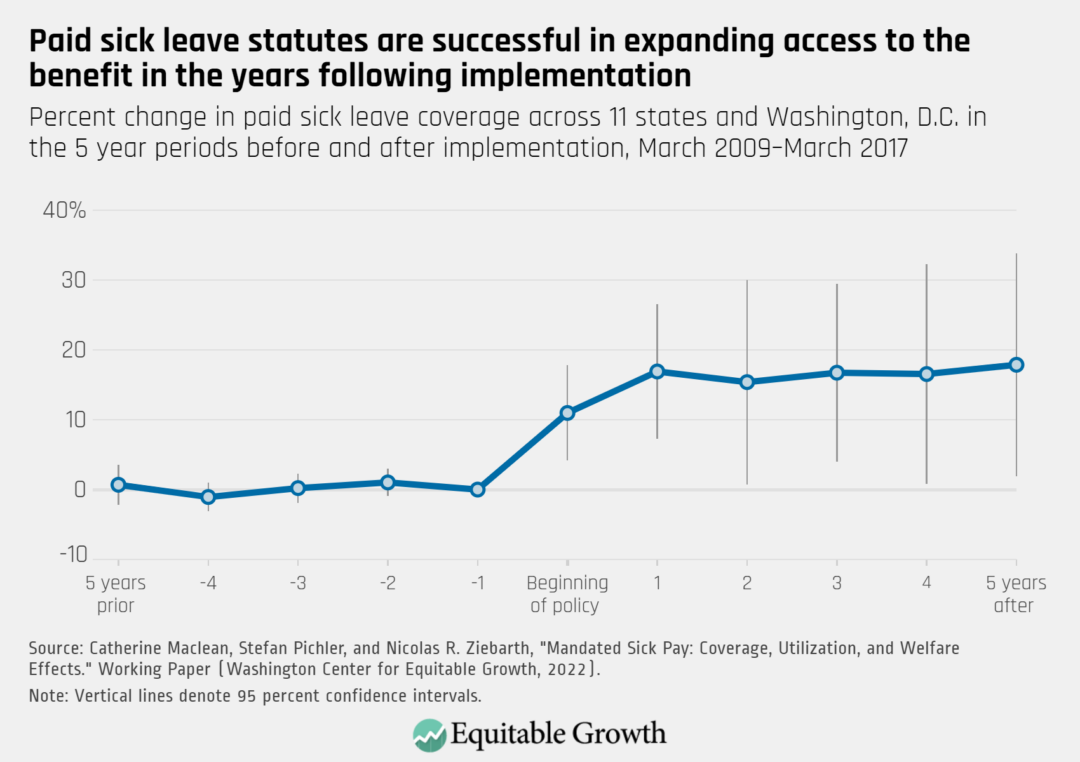Paid sick leave improves public health outcomes and supports U.S. workers at a relatively low cost to employers

The United States is one of only three high-income countries in the world that does not have a universal paid sick leave program available to its workforce. Although an emergency federal leave program was temporarily enacted under the Families First Coronavirus Response Act at the start of the coronavirus pandemic in March 2020 and then extended through September 30, 2021, it has now expired—despite the ongoing public health crisis now about to enter its third year.
In the absence of a nationwide paid sick leave program, over the past decade, many U.S. states and localities have implemented their own sick leave mandates. Thirty-six U.S. jurisdictions have laws that enable eligible workers to accrue paid time off from their employer; typically, workers earn 1 hour of paid sick time per 30 to 40 hours worked with the employer. These individual sick time accounts can be used when the worker or a family member experiences a short-term illness, and unused sick time rolls over to the next year.
Likewise, some U.S. employers voluntarily offer paid sick leave as a benefit, creating inequality in coverage across jobs and industries. In fact, data from the U.S. Bureau of Labor Statistics show that 97 percent of private-sector workers in finance and insurance occupations have access to paid sick leave, compared to just 49 percent of those in the food-services and accommodation industries.
This situation not only creates structural labor market inequities in which predominately lower income workers, disadvantaged workers, and workers of color lack access to paid sick leave. Limited and unequal access to paid sick leave also leads to undesirable outcomes for the economy as a whole, such as when unmet sick leave needs induce workers to quit their jobs, contributing to the current labor shortage, or make workers feel obligated to show up at work sick, contributing to the spread of infectious diseases.
Despite some misleading rhetoric, empirical studies do not find that sick pay mandates lead to economically significant employment losses or wage reductions at the regional labor market level. In fact, providing sick leave can even offset firms’ higher labor costs, as worker access to sick leave reduces presenteeism—showing up to work while sick. Further, surveys in jurisdictions with sick leave mandates suggest generally positive employer experiences with these programs
In our new working paper, “Mandated Sick Pay: Coverage, Utilization, and Welfare Effects,” we expand the previous literature that examines the U.S. labor market effects of guaranteed sick pay. We use firm-level data specifically designed and used by the federal government to pinpoint labor compensation, including benefits, to estimate the impact of these policies on employers’ provision of sick leave, worker utilization rates, labor costs, and other worker benefits.
We find that state-level sick pay mandates effectively increase the number of U.S. employers who offer paid sick leave to their employees. Worker access to sick pay increases by 18 percentage points within 2 years of the policy being adopted. (See Figure 1.)
Figure 1

This increase in coverage, we find, leads employees to use roughly 2 additional paid sick days per year, on average. At the same time, however, we find that approximately 1 in 5 workers still lacks access to sick pay even after the law is implemented. Further research is required to determine if this gap is a result of employer noncompliance, a lack of awareness that the policy exists, or any other factors.
In terms of the impact on other employee benefits, we find no evidence that they are curbed by employers in response to providing paid sick leave. These benefits, including paid vacation and holiday time off or group benefit policies, such as health or dental insurance, are valuable to employees, but U.S. employers are generally not required to provide them. Additionally, we do not find that employers cut hours worked for employees or reduce wages as a result of paid sick leave policies.
Mandated Sick Pay: Coverage, Utilization, and Welfare Effects
January 12, 2022
Our study uncovers modest increases in sick leave costs to employers. On average, employers incur an additional 2.7 cents per worker per hour to cover the cost of sick leave. For marginal firms newly covered by state-level policies, employers incur an additional 21 cents per worker per hour due to the new policies. In addition, employers may incur other indirect costs that we cannot measure—in productivity losses or reduced morale, for example, when workers are out sick. in contrast, employers may also accrue indirect savings if, for example, they increase rates of worker retention or reduce costs associated with workplace illness and presenteeism.
Indeed, our findings on the modest cost of sick leave are complemented by other research that examines the cost savings to businesses that are associated with these laws. A recent study by Heather Hill at the University of Chicago’s School of Social Service Administration on the impact of paid sick leave on job separation rates finds that it reduces the probability that a worker leaves their job by at least 2.5 percentage points, or 25 percent, with the strongest effects seen among working mothers and workers who do not receive paid time off for vacation.
Additionally, research suggests that businesses save on labor costs that no longer arise from presenteeism and the resulting enhanced productivity, and thus profitability, of workers who are all in good health.
Paid sick leave guarantees also are seen by many public health experts as one of the strongest tools in stopping the spread of infectious diseases. Research shows that paid sick leave reduces the spread of influenza. More recently, two other studies on the emergency paid sick leave program enacted under the Families First Coronavirus Relief Act show that it slowed the spread of the coronavirus by encouraging workers to stay at home when sick. And an OECD report from July 2020 argues that paid sick leave is “an effective social and employment policy response to protect income, health and jobs through the COVID-19 crisis.”
Paid sick leave policies not only improve public health outcomes but also support workers dealing with medical emergencies, lower rates of presenteeism, reduce inequality, likely boost worker productivity, and strengthen worker ties to the labor market. Sick pay also comes at a relatively low price-tag for employers. Importantly, it offers potential cost savings for employers through reduced sickness in the workplace, better worker moral and commitment to firms, or lower costs due to reduced turnover rates. It may even boost demand for products and services as customers generally appreciate when firms treat their employees well and generally dislike interactions with sick employees.
Policymakers should continue to advocate for, enact, and enforce sick pay policies as a cost-effective means of protecting the health of the public and strengthening the U.S. economy.





